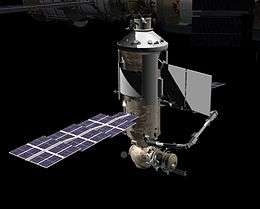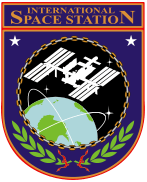Nauka (ISS module)

Nauka (Russian: Нау́ка; lit. Science), also known as the Multipurpose Laboratory Module (MLM), (Russian: Многофункциональный лабораторный модуль, or МЛМ), is a component of the International Space Station (ISS) which has not yet been launched into space. The MLM is funded by the Roscosmos State Corporation. In the original ISS plans, Nauka was to use the location of the Docking and Stowage Module. Later, the DSM was moved to Zarya's nadir port and named Rassvet. Planners anticipate Nauka will dock at Zvezda's nadir port, replacing Pirs.
The launch of Nauka, initially planned for 2007, has been repeatedly delayed. During 2013, the launch was re-scheduled to April 2014 and then to June 2014; NASA documents at that time indicated that the module would not fly before November 2015.[1][2][3] In April 2014 it emerged that the target date for launch was postponed to February 2017, as it became necessary to manufacture a new propulsion system for the module.[1] As of April 2016 the tentative launch date has slipped to November 2017, aboard a Proton M rocket.[4] New launch date - late 2018.
Original plans for Nauka
In the 1990s, plans for the Russian segment of the ISS included several research modules that were intended to be adjunct to Zarya and Zvezda. In these earlier plans, the now-cancelled complex of the Universal Docking Module (UDM) and the two newly developed Russian Research Modules were to be attached Zvezda's nadir port – the UDM was to be based on the Functional Cargo Block FGB-2. The FGB-2 was originally build as a backup for the original launch of the Zarya (FGB) module – FGB-2's construction had been halted at 70-percent completeness in the late 1990s.
However, the plans changed in the early 2000s. In August 2004, it was decided to build the Nauka ISS module based on the FGB-2.[5] During that time there was an alternate, rejected proposal for Nauka from RKK Energia, based on the cancelled Commercial Enterprise Module (entertainment and studio module), which was to be jointly funded by RKK Energia and SPACEHAB.[6]
Work on Nauka and launch date

At the end of 2005, the European Space Agency (ESA) agreed with the Russians that the European Robotic Arm would be launched together with Nauka, mated on its surface for a later deployment in space. A spare elbow joint for the European Robotic Arm was already launched together with Rassvet.
In 2004, the Russian Federal Space Agency stated that Nauka should be ready for launch in 2007 on a Russian Proton rocket. However, the Nauka project was delayed further, first to 2008 and later to 2009. A November 2006 ESA bulletin mentioned that the RSA was negotiating with the ISS partners to push back the prospective launch date to the end of 2008. In October 2011, it was reported that Nauka was expected to be launched at the end of 2013.[7] In May 2012, it was reported that the launch date had been pushed back to 2014.[8] The next planned launch date was April 2014, according to Vitaly Lopota, president of RSC Energia.[2]
On October 25, 2013, Parabolic Arc reported that Nauka was flawed and had failed acceptance testing at RKK Energia.[3] Found problems in the propulsion system included a leaking fueling valve that needed to be replaced and contamination, which would require a lengthy cleaning.[1] The module was to be returned to Khrunichev for repairs which would take another 12 to 18 months.[3] On November 27, 2013 it was reported that the Russian Space Agency had informed NASA that the launch had been postponed until at least 2015.[9] In April 2014 it emerged that the target date for launch was postponed to February 2017: a new propulsion system needed to be manufactured, as the installed had exceeded its warranty.[1]
Usage
Nauka will initially be used for experiments, docking and cargo. It will also serve as a crew work and rest area. Nauka will be equipped with full guidance and navigation control including engines and an attitude control system that can be used as a backup by the ISS. It will be docked onto the Zvezda module's nadir (Earth facing) docking port. Outfitting equipment launched in 2010 with the Rassvet (Mini-Research Module 1) on NASA's STS-132 will also be used for Nauka, including the spare elbow joint for the European Robotic Arm, internal hardware and an experimental airlock to be positioned on one of the side-facing ports at the bottom of the module. The new module will contain crew quarters with life support equipment including atmospheric processing, galley and toilet.[7]
Primary research module
Nauka will be Russia's primary ISS research module. For some time, NASA's official plans included a second research module around the same size as Nauka, listed to be "under review", but it was eventually cancelled, leaving Nauka to be the only Russian research module besides Rassvet and Poisk (Mini-Research Module 2).
Specifications
- Length: 13 metres (42.65 ft)
- Diameter: 4.11 metres (13.5 ft)
- Mass: 20,300 kilograms (44,800 lb)
- Pressurized volume: 70.0 m³
See also
References
- 1 2 3 4 MLM (FGB-2) module of the ISS - RussianSpaceWeb
- 1 2 О запусках новых российских модулей МКС
- 1 2 3 Роскосмос сообщил НАСА, что модуль МЛМ не войдет в состав МКС в 2014 г.
- ↑ Frommert, Hartmut (10 April 2016). "International Space Station Flight Schedule". Retrieved 28 April 2016.
- ↑ "02.26.97.iss.memo". nasawatch.com. 1997. Retrieved July 10, 2008.
- ↑ Zak, Anatoly. "Russian segment of the ISS". russianspaceweb.com. Retrieved 3 October 2009.
- 1 2 "New money for the old "Science"" (in Russian). Gazeta.ru. 2011-10-19. Retrieved 1 February 2012.
- ↑ Morring, Frank (23 May 2012). "Russia Sees Moon Base As Logical Next Step". Aviation Week. Retrieved 29 May 2012.
- ↑ "Russia Postpones Space Lab Launch Again". RIA Novosti. 27 November 2013. Retrieved 9 April 2014.
External links
| Wikimedia Commons has media related to Nauka module. |
- Description of MLM (English) (Russian) - Photos of the incomplete FGB-2 at Khrunichev.ru
- Новости российского сегмента МКС (Russian) - November 2004 article discussing plans for MLM
- MLM (FGB-2) module of the ISS - RussianSpaceWeb on the history of the module
- MLM (Nauka) - from Gunter's Space Page
- http://www.3dnews.ru/942263


